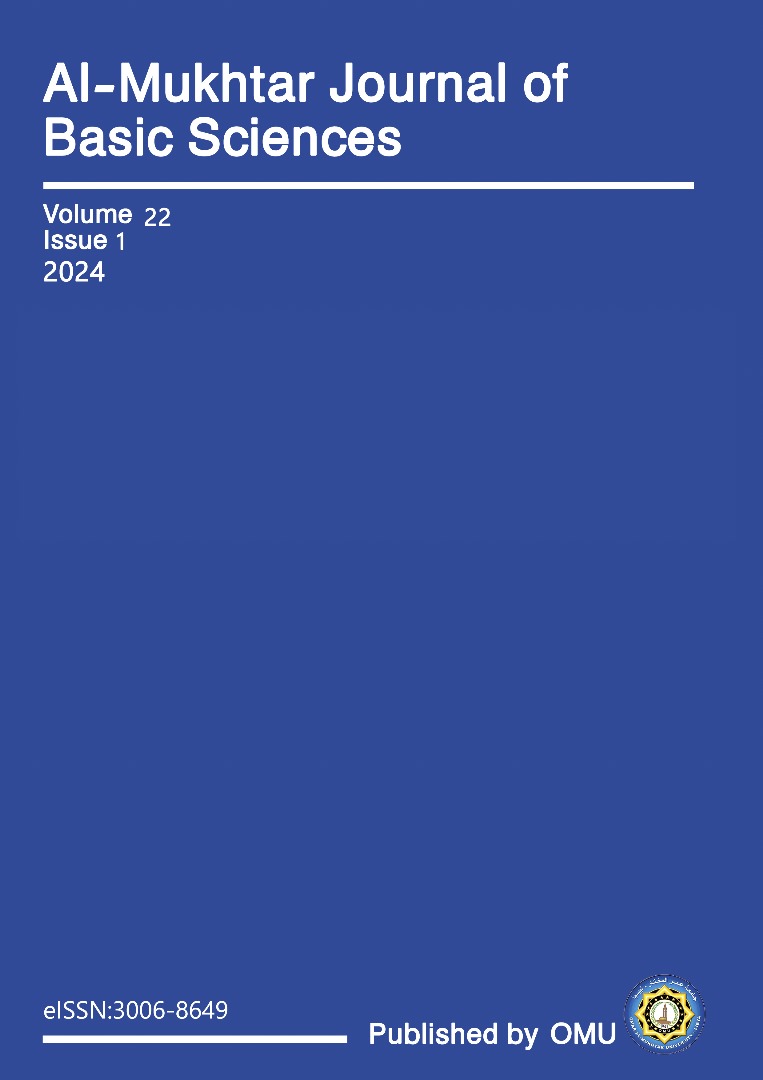Performance Evaluation of Artificial Neural Networks for Estimating Refer-ence Evapotranspiration in Shahat, Libya using limited climatic data
DOI:
https://doi.org/10.54172/0brvmk83Keywords:
Reference Evapotranspiration, FAO Penman-Monteith Equation, Artificial Neural NetworksAbstract
This study was conducted with the aim of evaluating the performance of artificial neural networks (ANNs) to estimate the reference evapotranspiration using limited climate data in Shahat region in Libya, compared to using the FAO Penman-Monteith equation (FPM), which requires temperature, wind speed, relative humidity and number of sunshine hours, which are rarely available in most meteorological stations in developing countries. In this study, we used the average temperature (Tmean) and the average relative humidity (RHmean) obtained from Shahat meteorological station for the period from 1963 to 1999, and the extraterrestrial radiation (Ra), which can be calculated given the location and time of the day. These data are divided into two groups, from 1963 to 1988 and from 1989 to 1999 for the training and validation phases of the neural networks, respectively. This study concluded that using (Tmean), (RHmean) and (Ra) gave the best agreement with the results calculated with the FAO Penman-Monteith equation, where the values of R2 and RMSE are equal to 0.98 and 0.26, respectively.
References
Abdel-Fattah, M. K., Kotb Abd-Elmabod, S., Zhang, Z., & Merwad, A.-R. M. (2023). Exploring the Applicability of Regression Models and Artificial Neural Networks for Calculating Reference Evapotranspiration in Arid Regions. Sustainability, 15(21), 15494.
Achite, M., Jehanzaib, M., Sattari, M. T., Toubal, A. K., Elshaboury, N., Wałęga, A., Krakauer, N., Yoo, J.-Y., & Kim, T.-W. (2022). Modern techniques to modeling reference evapotranspiration in a semiarid area based on ANN and GEP models. Water, 14(8), 1210.
Allen, R. G. (2000). REF-ET: Reference Evapotranspiration calculation software for FAO and ASCE standarized equatioin Version 3.1.16 for Windows. University of Idaho Research and Extension Center, Kimberly, Idaho
Allen, R. G., Clemmens, A. J., Burt, C. M., Solomon, K., & O’Halloran, T. (2005). Prediction accuracy for projectwide evapotranspiration using crop coefficients and reference evapotranspiration. Journal of Irrigation and Drainage Engineering, 131(1), 24-36.
Allen, R. G., Pereira, L. S., Raes, D., & Smith, M. (1998). Crop evapotranspiration: guidelines for computing crop water requirements. FAO Irrigation and Drainage Paper no. 56, Rome, Italy.
Allen, R. G., Pruitt, W. O., Wright, J. L., Howell, T. A., Ventura, F., Snyder, R., Itenfisu, D., Steduto, P., Berengena, J., & Yrisarry, J. B. (2006). A recommendation on standardized surface resistance for hourly calculation of reference ETo by the FAO56 Penman-Monteith method. Agricultural Water Management, 81(1-2), 1-22.
Bishop, C. (1995). Neural Networks for Pattern Recognition. University Press.
Dinpashoh, Y. (2006). Study of reference crop evapotranspiration in IR of Iran. Agricultural Water Management, 84(1-2), 123-129.
Ekhmaj, A. I. (2012). Prediction of evapotranspiration using artificial neural networks model. Malaysia In: International Annual Symposium on Sustainability Science and Management. Terengganu,
Ekhmaj, A. I., Ben Zagta, M., Daw Ezlit, Y., & Shaghleb, A. M. (2013). Estimation of the Reference Evapotranspiration in Sirt Region Using an Artificial Neural Networks. The Lybian Journal of Agriculture, 18(1-2), 1-14.
Genaidy, M. (2020). Estimating of evapotranspiration using artificial neural network. Misr Journal of Agricultural Engineering, 37(1), 81-94.
Haykin, Simon. 1999. "Neural networks a comprehensive introduction." In.: Prentice Hall, New Jersey.
Heramb, P., Singh, P. K., Rao, K. R., & Subeesh, A. (2023). Modelling reference evapotranspiration using gene expression programming and artificial neural network at Pantnagar, India. Information Processing in Agriculture, 10(4), 547-563.
Hrnjica, B. (2020). ANNdotNET--deep learning tool on. NET Platform. arXiv preprint arXiv:2009.11112.
Irmak, S., Irmak, A., Allen, R., & Jones, J. (2003). Solar and net radiation-based equations to estimate reference evapotranspiration in humid climates. Journal of Irrigation and Drainage Engineering, 129(5), 336-347.
Jain, A., & Kumar, A. (2006). An evaluation of artificial neural network technique for the determination of infiltration model parameters. Applied Soft Computing, 6, 272-282.
Kennedy, J. B., & Neville, A. M. (1986). Basic Statistical Methods for Engineers and Scientists (3rd ed.).
Kim, S., & Kim, H. S. (2008). Neural networks and genetic algorithm approach for nonlinear evaporation and evapotranspiration modeling. Journal of Hydrology, 351(3-4), 299-317.
Kumar, M., Raghuwanshi, N., & Singh, R. (2011). Artificial neural networks approach in evapotranspiration modeling: a review. Irrigation Science, 29(1), 11-25.
Kumar, M., Raghuwanshi, N., Singh, R., Wallender, W., & Pruitt, W. (2002). Estimating evapotranspiration using artificial neural network. Journal of Irrigation and Drainage Engineering, 128(4), 224-233.
Landeras, G., Ortiz-Barredo, A., & López, J. J. (2008). Comparison of artificial neural network models and empirical and semi-empirical equations for daily reference evapotranspiration estimation in the Basque Country (Northern Spain). Agricultural Water Management, 95(5), 553-565.
Minasny, B., & McBratney, A. B. (2002). The Neuro-m Method for Fitting Neural Network Parametric Pedotransfer Functions. Soil Science Society of America Journal, 66, 352-361.
Mohan, S., & Arumugam, N. (1996). Relative importance of meteorological variables in evapotranspiration: Factor analysis approach. Water Resources Management, 10(1), 1-20.
Nash, J. E., & Sutcliffe, J. V. (1970). River flow forecasting through conceptual models part I—A discussion of principles. Journal of Hydrology, 10(3), 282-290.
Odhiambo, L. O., Yoder, R. E., Yoder, D. C., & Hines, J. W. (2001). Optimization of fuzzy evapotranspiration model through neural training with input–output examples. Transactions of the ASAE, 44(6), 1625.
Oliveira, A. L. I., Braga, P. L., Lima, R. M. F., & Cornélio, M. L. (2010, 2010/11/01/). GA-based method for feature selection and parameters optimization for machine learning regression applied to software effort estimation. Information and Software Technology, 52(11), 1155-1166. https://doi.org/https://doi.org/10.1016/j.infsof.2010.05.009
Rajput, J., Singh, M., Lal, K., Khanna, M., Sarangi, A., Mukherjee, J., & Singh, S. (2023). Performance evaluation of soft computing techniques for forecasting daily reference evapotranspiration. Journal of Water and Climate Change, 14(1), 350-368.
Sudheer, K., A. Gosain, & K. Ramasastri. (2003). Estimating Actual Evapotranspiration from Limited Climatic Data Using Neural Computing Technique. Journal of Irrigation and Drainage Engineering, 129(3), 214-218. https://doi.org/doi:10.1061/(ASCE)0733-9437(2003)129:3(214)
Temesgen, B., Eching, S., Davidoff, B., & Frame, K. (2005). Comparison of some reference evapotranspiration equations for California. Journal of Irrigation and Drainage Engineering, 131(1), 73-84.
Trajkovic, S., Todorovic, B., & Stankovic, M. (2003). Forecasting of reference evapotranspiration by artificial neural networks. Journal of Irrigation and Drainage Engineering, 129(6), 454-457.
Tunalı, U., Tüzel, I. H., Tüzel, Y., & Şenol, Y. (2023). Estimation of actual crop evapotranspiration using artificial neural networks in tomato grown in closed soilless culture system. Agricultural Water Management, 284, 108331.
Downloads
Published
Issue
Section
License
Copyright (c) 2024 Mohamed A. Momen , Osama A. Abdelatty (Author)

This work is licensed under a Creative Commons Attribution-NonCommercial 4.0 International License.
Copyright of the articles Published by Al-Mukhtar Journal of Basic Sciences (MJBS) is retained by the author(s), who grant MJBS a license to publish the article. Authors also grant any third party the right to use the article freely as long as its integrity is maintained and its original authors and cite MJSc as the original publisher. Also, they accept the article remains published by the MJBS website (except in the occasion of a retraction of the article).












